Asthma Prevalence, Health Care Use and Mortality: United States, 2003-05
On This Page
by Lara Akinbami, M.D., Office of Analysis and Epidemiology
Asthma is a chronic respiratory disease characterized by episodes or attacks of inflammation and narrowing of small airways. Asthma attacks can vary from mild to life threatening. Symptoms can include shortness of breath, cough, wheezing, and chest pain or tightness. Many things can trigger asthma attacks such as allergens (e.g., pollen), infections, exercise, changes in the weather, and exposure to airway irritants (e.g., tobacco smoke).
The burden from asthma in the United States has increased over the past 2 decades. Trends from 1980-99 are presented in the CDC Asthma Surveillance Survey. This report presents the most recent data from the Centers for Disease Control and Prevention’s National Center for Health Statistics. Estimates by race/ethnicity and sex are age adjusted to allow comparison of rates between groups.
Asthma Prevalence, 2005
Three different asthma prevalence estimates are available from the National Health Interview Survey. Lifetime asthma diagnosis is defined as having ever been diagnosed with asthma by a doctor. People meeting this definition may or may not have had asthma at the time of the survey. Current asthma is defined as having been diagnosed with asthma and currently having asthma. Asthma attack is a crude way to identify people with symptomatic asthma and is defined as having been diagnosed with asthma and having at least one asthma attack in the previous 12 months.
Current asthma prevalence
In 2005, an estimated 7.7% of people (22.2 million) currently had asthma (Figure 1). Rates decreased with age; 8.9% of children (6.5 million) had asthma compared to 7.2% of adults (15.7 million). When race/ethnicity is considered, Puerto Ricans had a current asthma prevalence rate 125% higher than non-Hispanic white people and 80% higher than non-Hispanic black people. When only race is considered, American Indians and Alaska Natives and black people had a 25% higher prevalence than white people. Females had a 40% higher prevalence rate than males. This pattern was reversed among children aged 0-17 years. The current asthma prevalence for boys (10%) was 30% higher than for girls (7.8%) (data not shown).
Asthma attack prevalence
In 2005, an estimated 4.2% of people (12.2 million) had at least one asthma attack in the previous year (Figure 2). Among those who currently have asthma, about 55% had at least one asthma attack in the previous year. Asthma attack prevalence decreased with age: 5.2% of children (3.8 million) had an asthma attack in the previous year compared to 3.9% of adults (8.4 million). Puerto Ricans had the highest asthma attack prevalence, 140% higher than non-Hispanic white people. If only race is considered, the American Indians and Alaska Natives group had a 40% higher prevalence rate than white people. Females had about a 50% higher prevalence rate than males. This pattern was reversed among children ages 0-17 years. The asthma attack prevalence rate for boys (5.9%) was 30% higher than the rate among girls (4.5%) (data not shown).
Lifetime asthma diagnosis
In 2005, an estimated 11.2% of people, (32.6 million) had ever been diagnosed with asthma during their lifetime (Figure 3). Among adults, 10.7% had a lifetime asthma diagnosis (23 million) compared to 12.7% of children (9 million). Among all race and ethnicity groups, Puerto Ricans have the highest rate of lifetime asthma and Mexicans have the lowest. Puerto Ricans were 95% more likely to have ever been diagnosed with asthma than non-Hispanic white people. Considering race only, black people were about 20% more likely to have ever been diagnosed with asthma than white people. Females were about 20% more likely than males to ever have been diagnosed with asthma, but among children ages 0-17 years, males (14.6%) were more likely to have an asthma diagnosis than females (10.6%) (data not shown).
Missed school and work days, 2002 and 2003
Asthma attacks interfere with daily activities, including attending school and going to work. Table 1 shows school and work days missed due to asthma among those who reported at least one asthma attack in the previous year.
Table 1: Days missed due to asthma among those who reported at least one asthma attack in the previous year: United States, 2002-03
| Days missed 2002-2003 | 2002 | 2003 |
|---|---|---|
| School days, children 5-17 years | 14.7 million | 12.8 million |
| Work days, currently employed adults 18 years and over | 11.8 million | 10.1 million |
Source: National Health Interview Survey, National Center for Health Statistics, CDC
Health Care Use, 2004
Health care use for asthma includes outpatient visits to doctors’ offices and hospital outpatient departments, visits to hospital emergency departments (EDs), and hospitalizations. Information about Hispanic origin is not consistently available in national health care utilization data and, therefore, is not presented.
Outpatient asthma visits
In 2004, there were 14.7 million outpatient asthma visits to physician offices and hospital outpatient departments, or 508 per 10,000 people (Figure 4). Children had 7.0 million visits and an outpatient visit rate of 958 per 10,000 children, and adults had a rate of 356 per 10,000 adults. Black people had an outpatient visit rate about 18% higher than white people. Females had a 20% higher outpatient visit rate compared to males.
Emergency department asthma visits
There were 1.8 million visits to emergency departments (EDs) for asthma in 2004, or 64 per 10,000 people (Figure 5). Children had over 754,000 ED visits, a rate of 103 per 10,000 children. The ED visit rate was highest among children aged 0-4 years at 168 per 10,000 (data not shown). Adults had 50 ED visits per 10,000 adults. The ED visit rate for black people was 350% higher than that for white people.
Hospitalization for asthma
There were 497,000 asthma hospitalizations in 2004, or 17 per 10,000 people (Figure 6). Among children 0-17 years, there were 198,000 hospitalizations (27 per 10,000). Hospitalizations were highest among children 0-4 years, 60 hospitalizations per 10,000 (data not shown). The asthma hospitalization rate for black people was 240% higher than for white people. Females had a hospitalization rate about 35% higher than males.
Mortality, 2003
In 2003, 4,055 people died from asthma, or 1.4 per 100,000 people (Figure 7). Among children, asthma deaths are rare. In 2003, 195 children died from asthma, or 0.3 deaths per 100,000 children compared to 1.4 deaths per 100,000 adults. Puerto Ricans were the most likely to die from asthma and had asthma death rate 360% higher than non-Hispanic white people. Non-Hispanic black people had an asthma death rate 200% higher than non-Hispanic white people. Females had an asthma death rate 45% higher than males.
Data Sources
- Prevalence: National Health Interview Survey
- Outpatient visits: National Ambulatory Medical Care Survey and National Ambulatory Medical Care Survey
- Emergency department visits: National Hospital Ambulatory Medical Care Survey
- Hospitalizations: National Hospital Discharge Survey
- Mortality: Mortality component of the National Vital Statistics System
- U.S. Populations to calculate health care utilization and death rates: noninstitutionalized civilian population (outpatient visit and emergency department visit rates), civilian population (hospitalization rates), and residential population (mortality rates): U.S. Bureau of the Census monthly population estimates 2000-2005 (revised May 9, 2006). Residential population (mortality rates for Mexican and Puerto Rican subgroups): Technical Notes, Table V, Deaths, Final Data for 2003 [PDF – 1.9 MB].
More information
Data on asthma
- CDC’s Asthma Data and Surveillance
- Morbidity and Mortality Weekly Report Surveillance Summaries: Surveillance for Asthma — United States, 1980–1999, Centers for Disease Control and Prevention
- National Heart, Lung, and Blood Institute Morbidity and Mortality Chartbook
Economic and social costs
- Weiss KB, Sullivan SD. The health economics of asthma and rhinitis. I. Assessing the economic impact. J Allergy Clin Immunol 2001;107:3-8.
Asthma management and medical professional and patient education
- CDC’s Asthma Information
- National Asthma Education and Prevention Program Expert Panel Reports:
- Action Against Asthma: A Strategic Plan for the Department of Health and Human Services (May 2000)
- About asthma management, American Lung Association
Figures
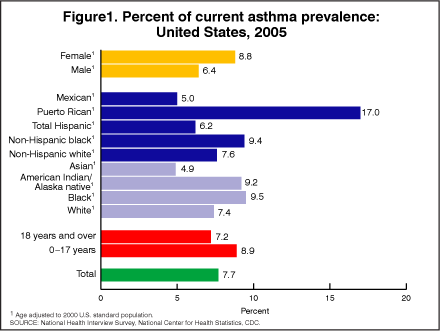
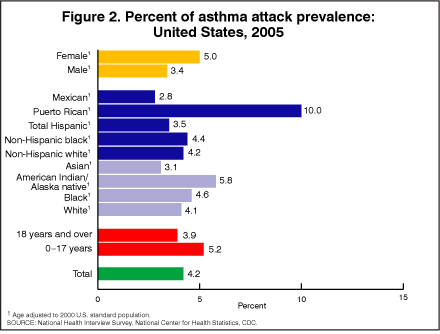
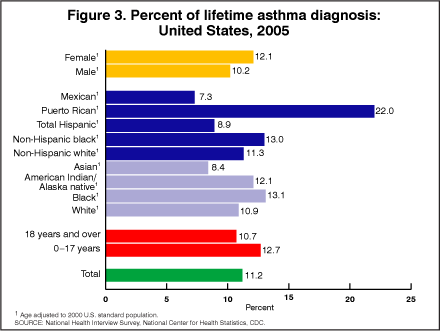
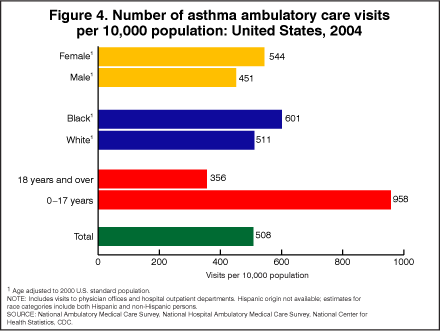

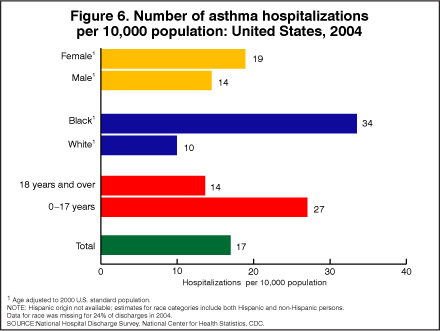
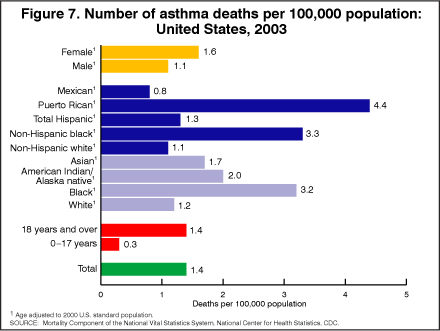
- Page last reviewed: November 6, 2015
- Page last updated: April 6, 2010
- Content source:


 ShareCompartir
ShareCompartir